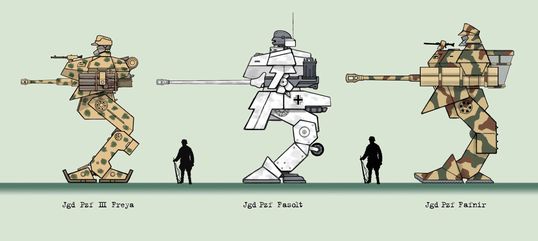Deutschland über alles!

Superiority Complex
German mechs are generally the highest quality in terms of stats and performance, but these advantages come with a significant price. They are the most expensive, and can be difficult to repair or replace. Given the diversity of German mechs, specific parts or units can be hard to come by. They are the divas of the battlefield.
German mechs are masters of combat. They have great sighting, and excel at both ranged and melee warfare. Deadly at all ranges. Their biggest mechanical disadvantage has to do with limited movement range and questionable reliability. They overburden rather easily. Breakdown potential is high and proportionate to threat level. Indeed, some very imposing German formations will sometimes falter under their own weight. Forcing these groups into excessive movement is a sound strategy.
Repair kits and actions have the least effectiveness on German vehicles. German engineering tends towards high complexity, making repair and recovery more difficult. German mechs also tend to be weak in compatibility with foreign parts.
German mech weapons, like their mechs, are excellent and diverse. For any mech weapon type, ranged, artillery, what have you... the Germans have lethal and well crafted option available.

Pzf = "Panzer Zu Fuss"
Literally, "Armor on foot" -Pzf is the native German term for their anthropomorphic walking panzers.
These have the same basic features of what the Allies refer to as AAFVs (antho armored fighting vehicles), consisting of 4 major sections; the head, hull (chest + crew compartment), fully articulated arms, and the leg section -everything bellow the waist ring, including engine and transmission.

Jagd-Pzf = Armor Hunters
Jagd-Pzf is the official German terminology for what is otherwise referred to as a "mech destroyer".
Like tank destroyers that are specifically designed to engage and destroy other tanks, Mechs Destroyers and Jagd-Pzfs are hunters; designed to hunt and kill other mechs.
Mechs of the 3rd Reich
Panzer Zu Fuss -"Pzf"
Hergestellt in Deutschland
Meaning in German, "Armor on foot", or "Walking armor", the term Pzf actually predates the Western Allied AAFV designation, as Axis Germany was the original source of the technology. When the 3rd Reich began stomping across European countries at brisk pace, the task was suddenly thrust upon the allies to either catch up with German Pzf Technology, or perish under its heels.
Delusions of Grandeur
While AAFVs adhere to the size designations of light, medium, and heavy mechs, German PZFs dramatically exceed that range on both ends of the scale by varying from Dwarf to Super-Heavy. A fact which reflects both the Axis power's ambition, and its habitual denial of logical limitations.

Small Beginnings
Dwarf Pzfs, like the Panzer I tank, were only ever intended as stopgaps before German war industry could build the momentum to produce superior vehicles. Most Pzfs in the light to heavy range are undeniable examples of German quality in engineering and innovation. Though as Germany's opponents proved, complexity of design is not always a war-winning trait, when measured against quantity and ease of operation. But until the Allies could rush out roughly equal counterparts to combat them, all German Pzfs enjoyed an interval of domination following their debut on the battlefield.
Jagd-Pzf
The German Mech Destroyer
Jagd Panzer Zu Fuss. A “hunting” Pzf. The German version of a Mech Destroyer. Designed specifically for fighting other mechs. Though they had reverse legs and weapon-arms in common, the heavily armed JgPzfs tended to be better armored than their US equivalents, due to the weight saving practice of eliminating waist rotation.
BlitzJäger Freya
A Jagd-Pzf III equipped with an experimental Tesla gun on the port arm mount, and a special generator on the starboard arm mount.
The crounching SdKlf (Sonderkamplaufer multi-use biped) lower left is for scale.

Heavy Jagd Pzf - "Fafnir"
A rough blueprint for a heavy German destroyer.
Note: the low crouching mode that is the specialty of any reverse-jointed mech destroyer.
This formidable specimen is combining the firepower of a JagdPanther's 88mm gun with the colossal 380mm rockets of a SturmTiger.
Sonder-Kampfläufer = SdKlf
Baby Blitz
Sonder-Kampfläufer is a broad German term for applied to various types of fighting walkers, excluding Pzfs. Armed SdKlfs were a typical weapon of early Blitz years.
The Sonder-Kampfläufers was an essential stepping stone for the recovering German industry, as it strove towards large scale production of the more complex walking armor.
On the shoulders of dwarves...
In addition to providing experience and knowledge to German industry, the SdKlf was similarly invaluable to Axis command for development of large-scale Pzf tactics.
Blitzkrieg was a revolutionary enough concept for warfare in WWII. Expert execution of such tactics with the added innovation of walking armor did not develop overnight.
The SdKlf was an early-war workhorse that was tethered to the German war machine well past its prime.
From Dawn till Dusk
Even after German Pzf production reached it's peak, massive losses on the eastern front meant chromic resupply problems.
Once again, The SdKlf stepped in to fill the gaps, and performed wherever legged weapon and materiel platforms were needed.
This duty included performance as a launch platform for many late-war wunder-weapons, which at least kept it employed away from the big-boy arena of the front lines.
















